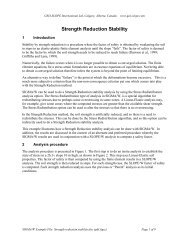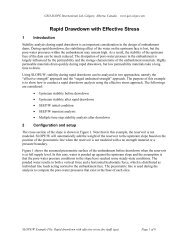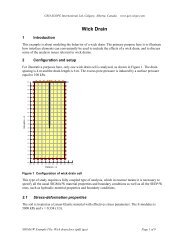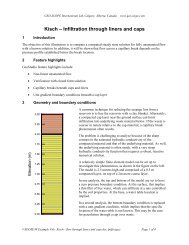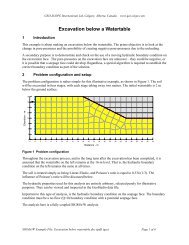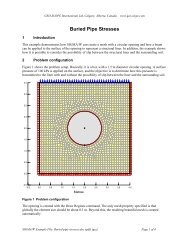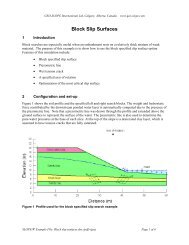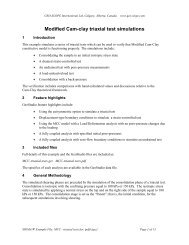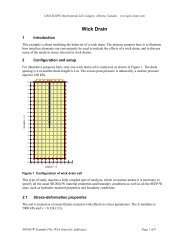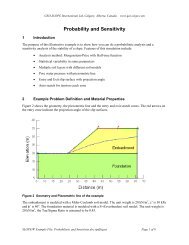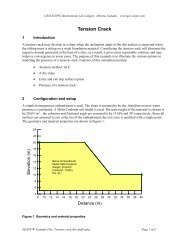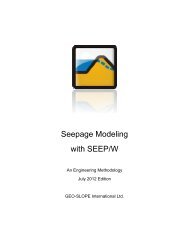Slope with ponded water.pdf - GEO-SLOPE International Ltd.
Slope with ponded water.pdf - GEO-SLOPE International Ltd.
Slope with ponded water.pdf - GEO-SLOPE International Ltd.
You also want an ePaper? Increase the reach of your titles
YUMPU automatically turns print PDFs into web optimized ePapers that Google loves.
<strong>GEO</strong>-<strong>SLOPE</strong> <strong>International</strong> <strong>Ltd</strong>, Calgary, Alberta, Canada www.geo-slope.com<br />
for some reason, the warning message will not appear. Please note that pressure lines are now referred to<br />
as surcharge loads in Version 7.1, which is more accurate.<br />
The new approach that has been implemented in Version 7.1 computes the stabilizing weight of the <strong>water</strong><br />
acting on the ground surface by looking at the positive pore-<strong>water</strong> pressures that exist along the ground<br />
surface. This approach will work for piezometric lines, pressure heads defined using a spatial function or<br />
finite element computed heads. The presence of positive pore-<strong>water</strong> pressures on the ground surface line<br />
will be visually represented by a shaded area showing the extent of the <strong>ponded</strong> <strong>water</strong> and <strong>with</strong> arrows<br />
indicating the direction that the <strong>water</strong> force will be acting on the free body. Water forces will act normal<br />
to the ground surface line.<br />
Pore-<strong>water</strong> pressures at the base of each slice will be computed differently depending on the method used.<br />
For piezometric lines, the vertical distance from the base of the slice up to the relevant piezometric line<br />
multiplied by the unit weight of <strong>water</strong> as defined under SET: Units and Scale, will determine the pore<strong>water</strong><br />
pressures that exist at the base. For pressure heads developed using a pressure head spatial function,<br />
the pore-<strong>water</strong> pressures will be determined using a numerical process called Kriging. For finite element<br />
generated pore-<strong>water</strong> pressures, the location of the base of the slice, relative to the nearest finite element<br />
nodes, will be determined and the pore-<strong>water</strong> pressures will be interpolated from the finite element<br />
computed results.<br />
For the example being described in this article, a piezometric line has been created and assigned to both<br />
the foundation and embankment materials. Accordingly, the stabilizing weight of the <strong>water</strong> will be<br />
applied in the analysis and is represented <strong>with</strong> a shaded zone and arrows.<br />
3.1 Case 1 – Water layer modeled <strong>with</strong> a piezometric line<br />
In this case, the <strong>ponded</strong> <strong>water</strong> is modeled <strong>with</strong> a piezometric line. Note that the piezometric line is drawn<br />
across the anticipated surface of the <strong>ponded</strong> <strong>water</strong> where pressure equals zero (P = 0). The area between<br />
the ground surface line and the piezometric line has been shaded to indicate the extent of positive pore<strong>water</strong><br />
pressures and arrows have also been painted along the ground surface to indicate the direction that<br />
the <strong>water</strong> force is acting.<br />
The global unit weight of <strong>water</strong> under SET: Units and Scale has been defined as 9.807 kN/m 3 as shown in<br />
Figure 2. This is the value that will be used together <strong>with</strong> the vertical height of the piezometric line to<br />
compute the correct pore-<strong>water</strong> pressure at the base of each slice. This is also the unit weight that will be<br />
used to compute the <strong>water</strong> force acting on the ground surface. If you want to use a different value, you<br />
can change the global value and then do a quick hand-calculation to confirm to yourself that the unit<br />
weight being used is what you have input.<br />
<strong>SLOPE</strong>/W Example File: <strong>Slope</strong> <strong>with</strong> <strong>ponded</strong> <strong>water</strong>.doc (<strong>pdf</strong>) (gsz) Page 2 of 7



